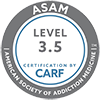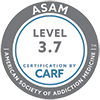You may recognize a group of sedatives called benzodiazepines by their brand names: Valium®, Xanax®, Halcion®, Ativan®, and Klonopin®. Commonly referred to as benzos, the earliest form of the drug first appeared on the American pharmaceutical market in the late 50s. It worked well to cause sedation or hypnosis, reduce anxiety, decrease muscle spasms, and lessen the severity and frequency of seizures. For a couple of decades, benzos were a go-to for doctors whose patients suffered from the following:
- Insomnia
- Seizures and muscle spasm disorders
- Acute agitation
- Moderate to severe anxiety
Benzos were also particularly useful in preparing patients for and administering anesthesia and helping people withdraw from alcohol. They interfered less with the respiratory systems of the patients who took it in comparison to earlier medications. This was seen as a huge gain.
By the early 80s, benzos had developed a strong negative reputation for dependency and abuse. The push for benzo sales in pharmacies across the United States paved the way for the drug to be abused by the elderly, teenagers, and people who also happened to abuse cocaine and heroin. Eventually, medical professionals began to avoid prescribing benzos for a period longer than four months, precisely because of their addictive qualities and negative long-term effects like:
- Disorientation or confusion
- Depression
- Headache and nausea
- Gastrointestinal discomfort
- Low blood pressure
- Slurred speech and blurred vision
- Incontinence issues
- Rashes and other skin reactions
At St. Gregory Recovery Center in Iowa, we see cases of benzo abuse every year. If you or a loved one are struggling with benzo misuse, we can help. We also encourage you to not judge yourself or your loved one harshly. Studies suggest that benzos are inherently addictive, quickly compromising an otherwise healthy brain. Dependence forms even faster in vulnerable populations, like teens and the elderly.
Teens and The Elderly: Two Vulnerable Populations
Teenagers and the elderly are more vulnerable to benzo addiction because of their unique struggles and pressures.
Teens can find themselves under heavy academic pressure, trying to balance their responsibilities to perform in school, sports, extracurricular activities, and at home. Whether they have been prescribed Xanax® or Klonopin®, for example, or get illicit access to these drugs, they learn that benzos successfully and quickly quell anxiety. The drugs can also help teens stay focused. Over the course of a few months, the anxiety relief and relaxation that the drugs provide can feel incredibly necessary. At that point, the teenage brain—still not yet 100% formed—doesn’t fully grasp the risks associated with the drug.
The elderly are also vulnerable. Socially isolated from friends or family at home or in an assisted-living environment, they may be struggling to cope with the death of a spouse, the new lifestyle that retirement creates, or a deteriorating physical state. They may have been prescribed a form of benzos to mitigate anxiety or another medical issue and become dependent on it in their loneliest phase of life. In the absence of regular family time or social stimulation, the elderly may fall onto benzos to escape, cope, or pass the time.
What’s needed for both groups–and for anyone who finds themselves addicted to benzos–is compassion and professional treatment.
St. Gregory Recovery Center Can Help Your Loved One Overcome Benzo Addiction
When you put your trust in our faith-based centers in Bayard or Des Moines, Iowa, we go above and beyond to provide caring, people-centered detox services and a holistic recovery program for the entire family. We pride ourselves on the comprehensive care that we offer, as it encompasses every aspect of spiritual, physical, and mental well-being. With us, you’ll be able to break the benzo cycle, learn new coping strategies, receive valuable recovery education, and create a life where a benzo dependence can’t easily take hold. Contact us today with any questions—we’re here to support you and yours!







